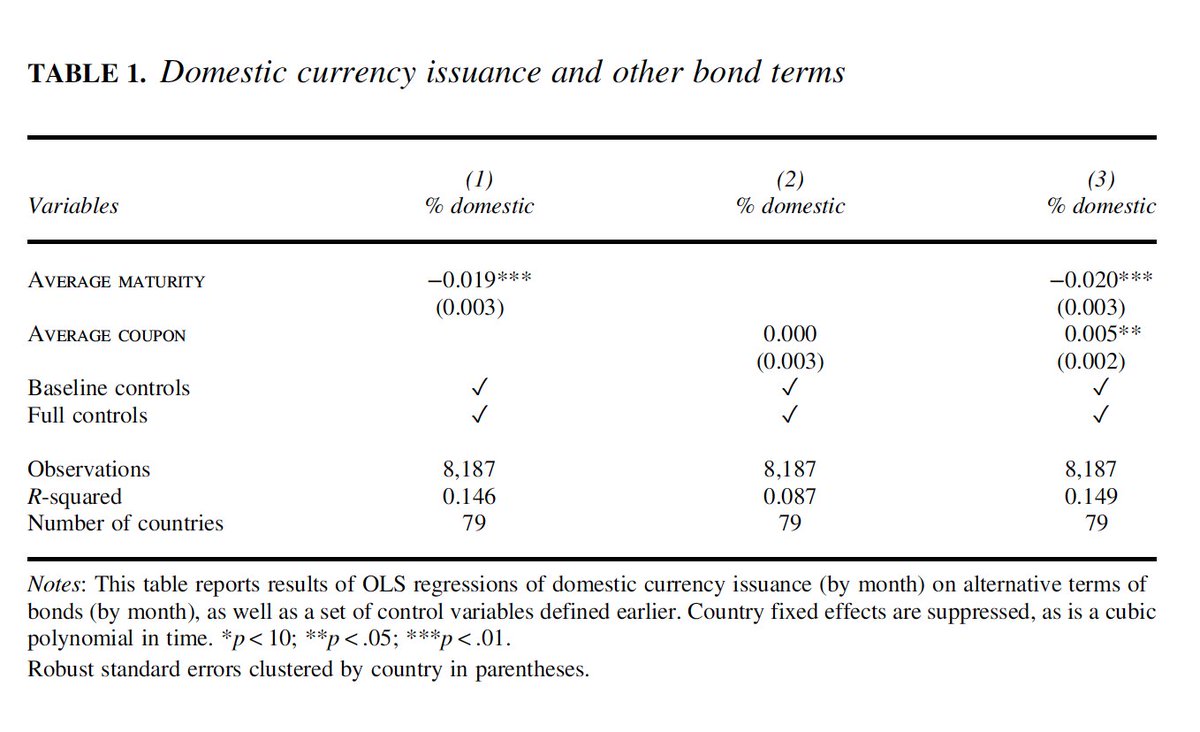
THREAD for sovereign debt geeks (and others who care about how governments' financing choices matter for all the other things governments do....):
New paper from @goodhouses, @UNCPoliSci's Cameron Ballard-Rosa & I, at @IntOrgJournal (now #FirstView and ungated all month).
[1]
New paper from @goodhouses, @UNCPoliSci's Cameron Ballard-Rosa & I, at @IntOrgJournal (now #FirstView and ungated all month).
[1]

"Coming to Terms: the Politics of Sovereign Bond Denomination"
We're interested in how non-OECD governments structure their bond borrowing.
Borrowing terms -- the currency, maturity structure, interest rate, as well as legal provisions -- matter.
Why? [2]
We're interested in how non-OECD governments structure their bond borrowing.
Borrowing terms -- the currency, maturity structure, interest rate, as well as legal provisions -- matter.
Why? [2]
Bond terms affect the extent to which governments experience market-related pressures in the future...do they need to generate foreign exchange to repay? How often must they roll over debt?
We focus on currency denomination: do gov'ts borrow in domestic or foreign currency?
[3]
We focus on currency denomination: do gov'ts borrow in domestic or foreign currency?
[3]
It was once the case that investors insisted on foreign-currency bonds for non-OECD borrowers.
But our data -- 240,000 bond issues, 131 countries, 1990-2016 -- suggest "original sin" is largely a thing of the past.
Many governments issue debt in their own currencies.
[4]
But our data -- 240,000 bond issues, 131 countries, 1990-2016 -- suggest "original sin" is largely a thing of the past.
Many governments issue debt in their own currencies.
[4]

Moreover, there's a partisan element to currency denomination: all else equal, left leaning governments are significantly more likely to issue debt in domestic (vs. foreign) currencies.
Doing so fits, we argue, with a desire to retain the ability to expand the money supply [5]
Doing so fits, we argue, with a desire to retain the ability to expand the money supply [5]

And it's not that left governments borrow more overall, nor that the prevalence of left governments has shifted dramatically over time [6]. 

Domestic currency denomination comes at a cost; it is associated with shorter maturities and higher interest rates.
And it appears to be facilitated by central bank independence, which ties governments' hands in a different way [7]

And it appears to be facilitated by central bank independence, which ties governments' hands in a different way [7]


We hope to draw attention to the significant variation in, and importance of *how* governments borrow;
and to suggest that borrowing terms are not only about the supply side (investors' assessments of risk), but also about the demand side (govts' preferences over terms)
[8]
and to suggest that borrowing terms are not only about the supply side (investors' assessments of risk), but also about the demand side (govts' preferences over terms)
[8]
PS: If you're interested in whether governments issue bonds at all, also see "BMW1"
[Short answer: domestic institutions & int'l market conditions both matter]
[end]
cambridge.org/core/journals/…
[Short answer: domestic institutions & int'l market conditions both matter]
[end]
cambridge.org/core/journals/…
And with a discussion of some broader issues related to sovereign debt:
https://twitter.com/PrincetonSPIA/status/1422267772134993930?s=20
• • •
Missing some Tweet in this thread? You can try to
force a refresh



